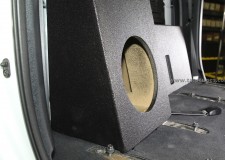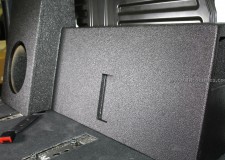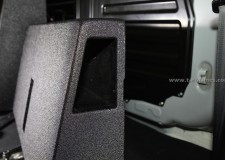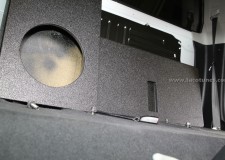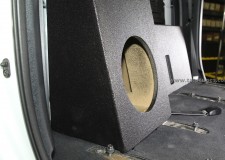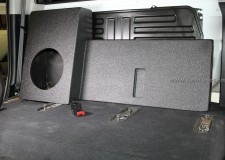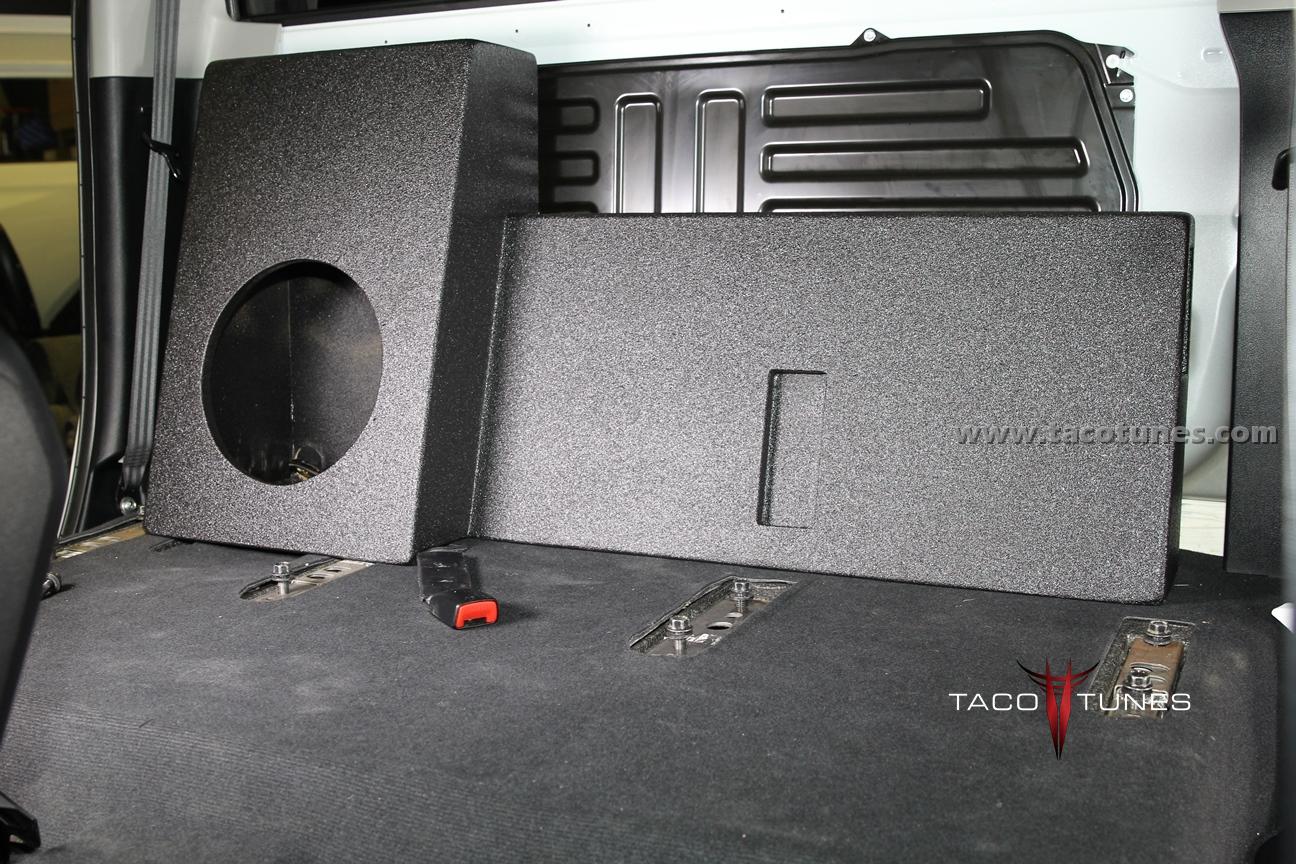
2014 Toyota Tundra CrewMax Ported Subwoofer box enclosure full size subwoofer
Toyota Tundra Full Size Subwoofer enclosure & Image Dynamics IDMAX 12″ Subwoofer
2014 Toyota Tundra CrewMax Ported Subwoofer box enclosure full size subwoofer Looking for tons of bass but still want amazing clarity? Nothing will bring your music to life better than a properly tuned subwoofer enclosure matched with a powerful subwoofer.Toyota Tundra Crew Max. This particular box will require moving the passenger side rear seat forward about 6″. You will have to use some brackets that we include with the enclosure. The large driver side seat will remain in the same position.
The subwoofer that we included with this setup is the very well known IDMAX from Image Dynamics. This sub is very well known for the amazing output while maintaining awesome sound quality. I have personally used these on my boat and beat them senseless for 8 hours straight and they lasted 3 summers at full volume. I am talking over 250 hours of CONSTANT PLAY at full volume. Unreal sound quality and bass output.
NOTE: WE will not sell this subwoofer box without the subwoofer. We matched the subwoofer to the box. Properly tuning a subwoofer to an enclosure is an art / science. We refuse to allow someone to install the wrong sub in our enclosures and put our name on that enclosure.
Challenges:
In 2014 Toyota changed the seat configuration on the Toyota Tundra CrewMax. In the previous model (2007-2013) the seats were adjustable. However in 2014 the rear seats were reconfigured; making it very difficult to install a subwoofer behind the seat of the Tundra.
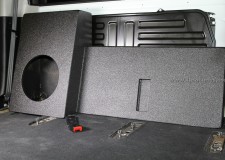
Installation Requirements:
To install this subwoofer you will need to remove the rear seats to gain access. There is some padding that is hanging behind the rear seats. The padding is easily removed by taking out the retaining clips. The tire iron bag carrier will need to be removed. We HIGHLY suggest matting the rear wall before installing the subwoofer. We include two bolts that allow you to bolt the subwoofer to existing mounting points in the Tundra. The bolts will keep the box from shifting and more importantly will alleviate any rattling from the box.
Information about Ported Boxes. A ported enclosure will generally have a better low frequency extension for a given responsive curve but generally requires a larger enclosure. Ported enclosures can’t be as small as sealed boxes . . . but a ported subwoofer box lends itself to a lower frequency response. In most cases a ported box will provide the lower end bass notes (extension) that many audio gurus are looking to obtain from their sound system. The challenge with ported boxes are MANY and can be difficult to overcome with little air space to work with. Sure it is easy to build a ported subwoofer box when you have a ton of air space! But the space behind the 2014 Tundra is nearly non-existent. To overcome this limited space we are using a shallow mount subwoofer for this particular enclosure. There are some disadvantages to shallow mounts subwoofers. Generally speaking, a shallow mount subwoofer does NOT produce the sound quality you would come to expect from a full size subwoofer. Often you are hard pressed to get the same lower end frequencies that really bring the music to life. Another common issue with shallow mount subwoofer is the lifespan of the subwoofer. Regardless of the common issues that plague shallow mounts subs, we were able to get some really good sound from a small subwoofer by properly port tuning the box. We will provide a list of subwoofers that we have tested Please keep in mind, if you purchase a subwoofer that is not on the list, chances are you will NOT be happy with the sound quality. As mentioned above, the box, port design and tuning all play a crucial role in properly designing a subwoofer enclosure. Information provided by: (Wikipedia) http://en.wikipedia.org/wiki/Thiele/Small “Thiele/Small” commonly refers to a set of electromechanical parameters that define the specified low frequency performance of a loudspeaker driver. These parameters are published in specification sheets by driver manufacturers so that designers have a guide in selecting off-the-shelf drivers for loudspeaker designs. Using these parameters, a loudspeaker designer may simulate the position, velocity and acceleration of the diaphragm, the input impedance and the sound output of a system comprising a loudspeaker and enclosure. Many of the parameters are strictly defined only at the resonant frequency, but the approach is generally applicable in the frequency range where the diaphragm motion is largely pistonic, i.e. when the entire cone moves in and out as a unit without cone breakup. Rather than purchase off-the-shelf components, loudspeaker design engineers often define desired performance and work backwards to a set of parameters and manufacture a driver with said characteristics or order it from a driver manufacturer. This process of generating parameters from a target response is known as synthesis. Thiele/Small parameters are named after A. Neville Thiele of the Australian Broadcasting Commission, and Richard H. Small of the University of Sydney, who pioneered this line of analysis for loudspeakers. History[ The 1925 paper of Chester W. Rice and Edward W. Kellogg, fueled by advances in radio and electronics, increased interest in direct radiator loudspeakers. In 1930, A. J. Thuras of Bell Labs patented (US Patent No. 1869178) his “Sound Translating Device” (essentially a vented box) which was evidence of the interest in many types of enclosure design at the time. Progress on loudspeaker enclosure design and analysis using acoustic analogous circuits by academic acousticians like Harry F. Olson continued until 1954 when Leo L. Beranek of the Massachusetts Institute of Technology published Acoustics,[1] a book summarizing and extending the electroacoustics of the era. J. F. Novak used novel simplifying assumptions in an analysis in a 1959 paper which led to a practical solution for the response of a given loudspeaker in a box, and also established their applicability by empirical measurement. In 1961, leaning heavily on Novak’s work, A. N. Thiele described a series of sealed and vented box “alignments” (i.e., enclosure designs based on electrical filter theory with well-characterized behavior, including frequency response, power handling, cone excursion, etc.) in a publication in an Australian journal.[2] This paper remained relatively unknown outside Australia until it was re-published in the Journal of the Audio Engineering Society in 1971. It is important to note that Thiele’s work neglected enclosure losses and, though a breakthrough at the time, his alignment tables now have little real-world utility. Many others continued to develop various aspects of loudspeaker enclosure design in the 1960s and early 1970s. From 1968-1972 J. E. Benson published three articles in an Australian journal that thoroughly analyzed sealed, vented and passive radiator designs, all using the same basic model. Beginning June 1972, Richard H. Small published a series of very influential articles in the Journal of the Audio Engineering Society restating and extending Thiele’s work. These articles were also originally published in Australia, where he had attended graduate school, and where his thesis supervisor was J.E. Benson. The work of Benson and Small overlapped considerably, but differed in that Benson did his work using computer programs and Small used analog simulators. Both researchers analyzed the systems including enclosure losses. Fundamental small signal mechanical parameters[edit] These are the physical parameters of a loudspeaker driver, as measured at small signal levels, used in the equivalent electrical circuit models. Some of these values are neither easy nor convenient to measure in a finished loudspeaker driver, so when designing speakers using existing drive units (which is almost always the case), the more easily measured parameters listed under Small Signal Parameters are more practical. Sd – Projected area of the driver diaphragm, in square meters. Fundamental small signal mechanical parameters[edit] These are the physical parameters of a loudspeaker driver, as measured at small signal levels, used in the equivalent electrical circuit models. Some of these values are neither easy nor convenient to measure in a finished loudspeaker driver, so when designing speakers using existing drive units (which is almost always the case), the more easily measured parameters listed under Small Signal Parameters are more practical. Sd – Projected area of the driver diaphragm, in square meters. Mms – Mass of the diaphragm/coil, including acoustic load, in kilograms.
2014 Toyota tundra crewmax ported subwoofer box enclosure
Mass of the diaphragm/coil alone is known as Mmd Cms – Compliance of the driver’s suspension, in meters per newton (the reciprocal of its ‘stiffness’). Rms – The mechanical resistance of a driver’s suspension (i.e., ‘lossiness’) in N·s/m Le – Voice coil inductance measured in millihenries (mH) (Frequency dependent, usually measured at 1 kHz). Re – DC resistance of the voice coil, measured in ohms. Bl – The product of magnet field strength in the voice coil gap and the length of wire in the magnetic field, in tesla-metres (T·m). Qualitative descriptions[edit] Cross-section of a dynamic cone loudspeaker. Image not to scale. FsAlso called F0, resonance frequency measured in hertz (Hz). The frequency at which the combination of the energy stored in the moving mass and suspension compliance is maximum, and results in maximum cone velocity. A more compliant suspension or a larger moving mass will cause a lower resonance frequency, and vice versa. Usually it is less efficient to produce output at frequencies below Fs, and input signals significantly below Fs can cause large excursions, mechanically endangering the driver. Woofers typically have an Fs in the range of 13–60 Hz. Midranges usually have an Fs in the range of 60–500 Hz and tweeters between 500 Hz and 4 kHz. A typical factory tolerance for Fs spec is ±15%.QtsA unitless measurement, characterizing the combined electric and mechanical damping of the driver. In electronics, Q is the inverse of the damping ratio. The value of Qts is proportional to the energy stored, divided by the energy dissipated, and is defined at resonance (Fs). Most drivers have Qts values between 0.2 and 0.5, but there are valid (if unusual) reasons to have a value outside this range. QmsA unitless measurement, characterizing the mechanical damping of the driver, that is, the losses in the suspension (surround and spider.) It varies roughly between 0.5 and 10, with a typical value around 3. High Qms indicates lower mechanical losses, and low Qms indicates higher losses. The main effect of Qms is on the impedance of the driver, with high Qms drivers displaying a higher impedance peak. One predictor for low Qms is a metallic voice coil former. These act as eddy-current brakes and increase damping, reducing Qms. They must be designed with an electrical break in the cylinder (so no conducting loop). Some speaker manufacturers have placed shorted turns at the top and bottom of the voice coil to prevent it leaving the gap, but the sharp noise created by this device when the driver is overdriven is alarming and was perceived as a problem by owners. High Qms drivers are often built with nonconductive formers, made from paper, or various plastics.QesA unitless measurement, describing the electrical damping of the loudspeaker. As the coil of wire moves through the magnetic field, it generates a current which opposes the motion of the coil. This so-called “Back-EMF” (proportional to Bl * velocity) decreases the total current through the coil near the resonance frequency, reducing cone movement and increasing impedance. In most drivers, Qes is the dominant factor in the voice coil damping. Qes depends on amplifier output impedance. The formula above assumes zero output impedance. When an amplifier with nonzero output impedance is used, its output impedance should be added to Re for calculations involving Qes. BlMeasured in tesla-metres (T·m). Technically this is B×l or B×l sin(θ) (a vector cross product), but the standard geometry of a circular coil in an annular voice coil gap gives sin(θ)=1. B×l is also known as the ‘force factor’ because the force on the coil imposed by the magnet is B×l multiplied by the current through the coil. The higher the B×l value, the larger the force generated by a given current flowing through the voice coil. B×l has a very strong effect on Qes. VasMeasured in litres (L) or cubic metres, is a measure of the ‘stiffness’ of the suspension with the driver mounted in free air. It represents the volume of air that has the same stiffness as the driver’s suspension when acted on by a piston of the same area (Sd) as the cone. Larger values mean lower stiffness, and generally require larger enclosures. Vas varies with the square of the diameter. A typical factory tolerance for Vas spec is ±20–30%.MmsMeasured in grams (g) or kilograms (kg), this is the mass of the cone, coil and other moving parts of a driver, including the acoustic load imposed by the air in contact with the driver cone. Mmd is the cone/coil mass without the acoustic load, and the two should not be confused. Some simulation software calculates Mms when Mmd is entered. Mmd can be very closely controlled by the manufacturer. RmsUnits are not usually given for this parameter, but it is in mechanical ‘ohms’. Rms is a measurement of the losses, or damping, in a driver’s suspension and moving system. It is the main factor in determining Qms. Rms is influenced by suspension topology, materials, and by the voice coil former (bobbin) material. CmsMeasured in meters per newton (m/N). Describes the compliance (ie, the inverse of stiffness) of the suspension. The more compliant a suspension system is, the lower its stiffness, so the higher the Vas will be. Cms is proportional to Vas and thus has the same tolerance ranges. ReMeasured in ohms (Ω), this is the DC resistance (DCR) of the voice coil, best measured with the cone blocked, or prevented from moving or vibrating because otherwise the
2014 Toyota tundra crewmax ported subwoofer box enclosure
pickup of ambient sounds can cause the measurement to be unreliable. Re should not be confused with the rated driver impedance, Re can be tightly controlled by the manufacturer, while rated impedance values are often approximate at best.. American EIA standard RS-299A specifies that Re (or DCR) should be at least 80% of the rated driver impedance, so an 8-ohm rated driver should have a DC resistance of at least 6.4 ohms, and a 4-ohm unit should measure 3.2 ohms minimum. This standard is voluntary, and many 8 ohm drivers have resistances of ~5.5 ohms, and proportionally lower for lower rated impedances. LeMeasured in millihenries (mH), this is the inductance of the voice coil. The coil is a lossy inductor, in part due to losses in the pole piece, so the apparent inductance changes with frequency. Large Le values limit the high frequency output of the driver and cause response changes near cutoff. Simple modeling software often neglects Le, and so does not include its consequences. Inductance varies with excursion because the voice coil moves relative to the polepiece, which acts as a sliding inductor core, increasing inductance on the inward stroke and decreasing it on the outward stroke in typical overhung coil arrangements. This inductance modulation is an important source of nonlinearity (distortion) in loudspeakers. Including a copper cap on the pole piece, or a copper shorting ring on it, can reduce the increase in impedance seen at higher frequencies in typical drivers, and also reduce the nonlinearity due to inductance modulation. Sd Measured in square meters (m²). The effective projected area of the cone or diaphragm. It is difficult to measure and depends largely on the shape and properties of the surround. Generally accepted as the cone body diameter plus one third to one half the width of the annulus (surround). Drivers with wide roll surrounds can have significantly less Sd than conventional types with the same frame diameter. XmaxSpecified in millimeters (mm). In the simplest form, subtract the height of the voice coil winding from the height of the magnetic gap, take the absolute value and divide by 2. This technique was suggested by JBL’s Mark Gander in a 1981 AES paper, as an indicator of a loudspeaker motor’s linear range. Although easily determined, it neglects magnetic and mechanical non-linearities and asymmetry, which are substantial for some drivers. Subsequently, a combined mechanical/acoustical measure was suggested, in which a driver is progressively driven to high levels at low frequencies, with Xmax determined by measuring excursion at a level where 10% THD is measured in the output. This method better represents actual driver performance, but is more
2014 Toyota tundra crewmax ported subwoofer box enclosure
difficult and time-consuming to determine. PeSpecified in watts. Frequently two power ratings are given, an “RMS” rating and a “music” (or “peak”, or “system”) rating, usually peak is given as ~2 times the RMS rating. Loudspeakers have complex behavior, and a single number is really unsatisfactory. There are two aspects of power handling, thermal and mechanical. The thermal capacity is related to coil temperature and the point where adhesives and coil insulation melt or change shape. The mechanical limit comes into play at low frequencies, where excursions are largest, and involves mechanical failure of some component. A speaker that can handle 200 watts thermally at 200Hz, may sometimes be damaged by only a few watts at some very low frequency, like 10Hz. Power handling specifications are usually generated destructively, by long term industry standard noise signals (IEC 268, for example) that filter out low frequencies and test only the thermal capability of the driver. Actual mechanical power handling depends greatly on the enclosure in which the driver is installed. VdSpecified in litres (L). The volume displaced by the cone, equal to the cone area (Sd) multiplied by Xmax. A particular value may be achieved in any of several ways. For instance, by having a small cone with a large Xmax, or a large cone with a small Xmax. Comparing Vd values will give an indication of the maximum output of a driver at low frequencies. High Xmax, small cone diameter drivers are likely to be inefficient, since much of the voice coil winding will be outside the magnetic gap at any one time and will therefore contribute little or nothing to cone motion. Likewise, large cone diameter, small Xmax drivers are likely to be more efficient as they will not need, and so may not have, long voice coils.η0 – Reference Efficiency Specified in percent (%). Comparing drivers by their calculated reference efficiency is often more useful than using ‘sensitivity’ since manufacturer sensitivity figures are too often optimistic. SensitivityThe sound pressure, in dB, produced by a speaker in response to a specified stimulus. Usually this is specified at an input of 1 watt or 2.83 volts (2.83 volts = 1 watt into an 8 ohm load) at a distance of one meter. Mms – Mass of the diaphragm/coil, including acoustic load, in kilograms. Mass of the diaphragm/coil alone is known as Mmd Cms – Compliance of the driver’s suspension, in meters per newton (the reciprocal of its ‘stiffness’). Rms – The mechanical resistance of a driver’s suspension (i.e., ‘lossiness’) in N·s/m Le – Voice coil inductance measured in millihenries (mH) (Frequency dependent, usually measured at 1 kHz). Re – DC resistance of the voice coil, measured in ohms. Bl – The product of magnet field strength in the voice coil gap and the length of wire in the magnetic field, in tesla-metres (T·m). 2014 Toyota tundra crewmax ported subwoofer box enclosure
- Measuring Thiele Small Parameters (method 1 – the classic method)
- Measuring parameters (method 2)
- Fast Bass, Slow Bass – Myth vs. Fact
- Understanding Power Compression
- Acoustic Analogous Circuits – the method behind the formulas
- The Thiele-Small Loudspeaker Database
2014 Toyota tundra crewmax ported subwoofer box enclosure
